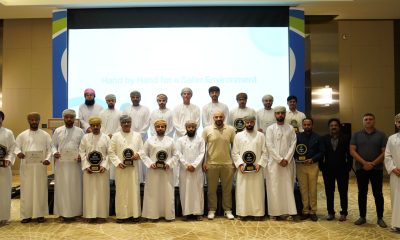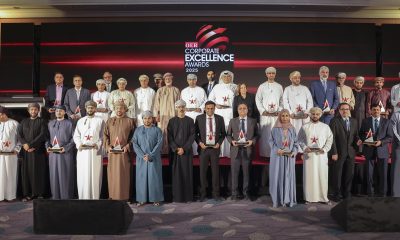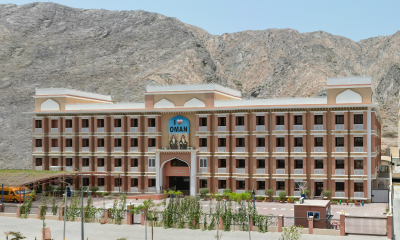Interviews
Driving Innovation in Digitization
Shukri Eid, Managing Director – East Region, Cisco Middle East talks about how IoT and innovation pave the way for digital transformation in Oman

In your opinion, how does Cisco promote a culture of innovation in a country?
The potential for countries to prosper in the coming decade is staggering. In the past few years, the mass digitization of business and society has pressured every organization – large and small, private and public – to innovate at unprecedented speed. To develop vibrant digital economies, Cisco is supporting governments’ efforts to foster an innovation, talent and entrepreneurship ecosystem through various programs and initiatives, including our Country Digital Acceleration (CDA) program and Cisco Networking Academy.
As we support nations to reach new heights in the digital era, a key focus for Cisco is to support the development of a sustainable innovation ecosystem that can help drive digitization. At a country level, our approach is to partner with government entities, industry and academia to help develop an entrepreneurial culture and mindset that encourages collaborations and co-creation and which can create a virtuous cycle of innovation. Key to establishing an innovation infrastructure is the development of sophisticated IT network ecosystems that allow for greater connectivity, productivity, and security – all of which are priority areas for Cisco.
Cisco has also deployed a global network of Innovation Centers which allow entrepreneurs, partners and startups to collaborate and work on their innovative ideas, from brainstorming to validation to rapid prototyping.
As Oman accelerates its digitization and continues to drive its economic diversification efforts, there is a growing need for skilled, tech-savvy human capital to fill the new jobs created by the digital era. Bridging the skills gap, particularly in the ICT field, continues to be a top government priority in Oman and the broader Gulf region. Developing talent locally is one of the areas where Cisco’s Networking Academy, a global IT skills and career building program, is making an impact by working closely with local schools, universities and government organizations to train and enable students to compete and thrive in the current and future job market.
To promote innovation in the region, Cisco also opened a state-of-the-art Innovation and Experience Centre in Dubai in November 2017 to serve as a hub for open innovation, bringing together communities of customers, partners, start-ups, accelerators, governments, universities and research communities to foster the exploration and development of new technologies.
Is Oman on track to adopt and use of IoT solutions and technologies?
Oman has been relentless in its pursuit of technological excellence and its vision of transforming the Sultanate into a sustainable knowledge-based economy is exemplified by its bold commitments to the eOman Strategy, which aims to build the region’s most advanced IoT ecosystem to improve people’s lives.
The strategy drives the Sultanate’s smart transformation forward as it strives to digitize more aspects of people’s everyday life. Oman has adopted a forward-thinking policy that prioritizes innovation, digital transformation, and the adoption of advanced technologies and this has helped it gain regional recognition as a benchmark for leveraging technology to provide public services. According to the Information Technology Authority, the platform for IoT in Oman is ready, and it is now up to the sectors to implement it as they want. The major sectors looking to implement it are manufacturing, logistics and tourism.
Estimates show that 50 billion devices may be connected to the internet by 2020 around the world, with investments in the technology reaching billions of dollars. An A.T. Kearney’s report has predicted that by 2025, the IoT solutions market in the GCC will be worth $11 billion, generating potential value for the economy of nearly $160 billion (AED 587.68 billion). Oman is well positioned to benefit and prosper from the huge potential that IoT brings.
What steps should be taken to develop infrastructure and systems to enable the use of IoT technologies in different services or sectors?
The IoT is accelerating the digital world. Transforming businesses with contextual insights from IoT data has become an imperative for organizations in all industries. However, connecting things securely, analyzing data dynamically, and delivering business value demand an intelligent network and IoT platform.
IoT is placing new demands on network infrastructure. IoT applications require high-speed connections, an extremely low latency response, and integrated security. Organizations also need a flexible and scalable wired and wireless network infrastructure. This helps to easily deploy IoT applications, from the cloud to the network edge with fog computing.
A successful IoT platform should be able to connect the IoT endpoints to the applications and analytics required to generate business outcomes. It is the center of the entire IoT solution as it enables data generated at the endpoints to be processed and analyzed and used meaningfully by end-users. IoT is at a stage where disparate networks and a multitude of sensors must come together and interoperate under a common set of standards. This effort will require businesses, governments, standards organizations, and academia to work together towards a common goal.
Which are the sectors that you believe will benefit the most from IoT technologies in Oman?
The benefits of IoT are seen in several sectors in the Oman including smart transportation, telecoms, healthcare, utilities, manufacturing, oil and gas, automotive and government. Other verticals, which are adopting IoT include education, banking and finance, retail and sports, to name a few. Verticals such as manufacturing and transportation use large data sets to optimize operations processes and extend the life of high-capital cost assets, while sectors like healthcare use IoT technology to produce benefits that improve the quality of life. Hospitals in Oman are increasingly investing in technology to offer some of the highest quality healthcare services in the region.
In the oil and gas sector, budget constraints are pushing crude producers to improve and increase efficiencies by exploring ways to make its oilfields smarter, such as with unmanned oilfields, and by leveraging IoT technology to digitize operations and benefit from big data and analytics, sensors, and control systems.
R&D would be an important component to smart city development. How much do you spend on R & D over a given period of time?
The industry in which we compete is subject to rapid technological developments, evolving standards, changes in customer requirements, and new product introductions and enhancements. As a result, our success depends in part upon our ability to continue to enhance our existing products and to develop and introduce new products and features that improve performance, and reduce total cost of ownership.
Cisco spends close to 15% of its revenue on R&D, producing innovations across our portfolio. Cisco’s spending on R&D over the past few years has been above US $6bn annually. Cisco has more than 170 labs worldwide and about 85 percent of our approximate 25,000 engineers are software engineers while 7,000 of our 19,000 patents are focused on software.
Cisco also has an Entrepreneurs in Residence program, where we provide financial support, mentoring, and collaboration opportunities to early-stage entrepreneurs working in areas where we see huge potential, such as big data analytics, cloud computing, and enterprise security.
How does Cisco set itself apart when it comes to innovation experience?
In a world of rapid transformation, businesses must continually innovate to remain successful. Cisco has always looked beyond the curve and has kept innovating in order to be prepared for technology disruptions. This has meant taking tough decisions and immersing itself in a process of disrupting the market, which at times disrupts our business too. Though market disruptions could be looked at as a threat to business, Cisco views them as an opportunity. That is why Cisco keeps transforming its entire business, expanding to capture growth and thinking very differently about the future of information technology.
For Cisco, innovation is who we are and always have been. It’s part of Cisco’s DNA, and a top corporate priority. We realize there’s no monopoly on innovation, and we believe the next billion-dollar idea can come from anywhere. 16 Cisco organizations have their own innovation programs and we have Innovation Spaces across many Cisco campuses.
At Cisco, we strive to breed a culture of innovation by implementing certain practices that foster it. Some of those practices include having over one third of our engineers working in an agile development environment and generally working on smaller, more agile teams. We also support what are called “Alpha” projects that facilitate disruptive new technologies that drive innovation. As a result of these efforts, Cisco has been able to generate 19,000 patents globally.
Our innovation strategy, in order of priority, is to build, buy, partner and invest. We’ve managed to launch several innovative and disruptive technologies, which is, sometimes, several years ahead of its time. Cisco is the world leader in security, networking and collaboration because we continually invest and innovate for tomorrow.
Cisco is also the ‘Digital Network Partner’ for World Expo in 2020. What kind of a digital experience will you be providing to partners and attendees?
As the Digital Network Partner for World Expo 2020, Cisco will provide the secure, intelligent foundation for connectivity through its intent-based networking solution, making Expo 2020’s technology infrastructure the most advanced in the event’s 167-year history. Designed for the demands of the digital era, Cisco® intent-based network provides an infrastructure that constantly learns, adapts and protects, making it the ideal foundation for the complete digital experience offered at Expo 2020 Dubai. It will also help enable visitors, exhibitors and organizers to connect anywhere, on any device – securely, reliably and seamlessly.
We will also provide Cisco Vision™ signage solution with thousands of displays throughout the Expo 2020 Dubai site, which will be one of the largest deployments of the Cisco Vision signage solution – the largest of its kind in the region and one of the largest globally. The solution provides dynamic signage and high-definition digital content and video that will help enable more than 200 international participants to offer compelling, interactive experiences and engage with visitors and employees in new and more impactful ways.
Cisco will also help ensure that connectivity between systems is secure, a vital requirement not just for organizers but also the 200-plus participants that include nations, multi-lateral corporations, NGOs and educational institutions.
This interview was first published in OER Dossier – Comex 2018 Special Issue
-

 Banking & Finance2 weeks ago
Banking & Finance2 weeks agoOman Oil Marketing Company Concludes Its Annual Health, Safety, Environment, and Quality Week, Reaffirming People and Safety as a Top Priority
-

 Economy2 months ago
Economy2 months agoMaal Card: What Oman’s New National Payment Card Means for Everyday Users
-

 Events2 months ago
Events2 months agoOER Corporate Excellence Awards 2025 Honours Entities and Innovations in Oman
-

 News2 months ago
News2 months agoSheikh Suhail Bahwan, Chairman of Suhail Bahwan Group, Passes Away
-

 News1 month ago
News1 month agoOIG Appoints New CEO to Lead Its Next Chapter of Excellence
-

 Economy2 months ago
Economy2 months agoOman Unveils Official Omani Rial Symbol in Landmark Move to Boost Global Currency Presence
-

 News1 month ago
News1 month agoReport: How India & The Middle East Are Exploiting Immense Economic Synergies
-

 Uncategorized1 month ago
Uncategorized1 month agoOman’s ISWK Cambridge Learners Achieve ‘Top in the World’ and National Honours in June 2025 Cambridge Series




























You must be logged in to post a comment Login